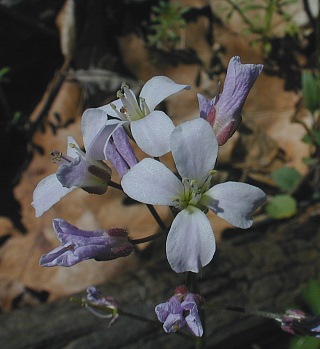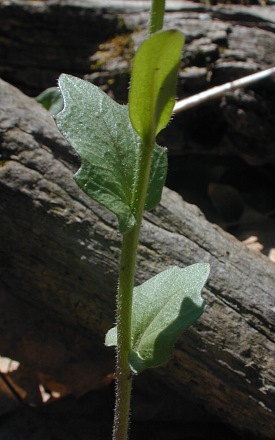Description:
This
perennial wildflower is 4-12" tall and unbranched, except for possibly
1-2 flowering side stems near the apex. The erect central stem is light
green to purplish green, terete, and hairy. At the base of each plant,
1-2 basal leaves are commonly present; they are about 1" long and
across, cordate-orbicular, and bluntly dentate or undulate along their margins.
Each basal leaf has a long slender petiole. The alternate leaves are up
to 2" long and 1" across; they are oval-ovate to oblong, bluntly
dentate or undulate along the margins, and ciliate. At the base, the
alternate leaves are sessile or slightly clasp the central stem. The
alternate leaves become slightly shorter and more narrow as they ascend
the stem. The central stem terminates in a raceme of flowers. The
flowers and buds are concentrated toward the apex of the raceme, while
cylindrical seedpods (siliques) develop along the remainder of the
raceme. Each flower is about ½–¾" across, consisting of 4 petals, 4
sepals, several stamens, and a single stout style of the pistil. The
petals are pale purple or purple-tinted white and obovate in shape. The
sepals are purple, hairy, and membranous-white along their margins. The
petals are much longer than the sepals. The blooming occurs during
mid-spring and lasts about 2 weeks. The flowers are fragrant. Each
flower is replaced by an ascending silique up to 1" long. The 2-valved
siliques are green to purple; each silique contains a single row of
seeds and it has a stout pedicel up to 1" long at its base. Eventually,
the silique splits in half lengthwise to release the seeds. The root
system is fibrous and tuberous.
cordate-orbicular, and bluntly dentate or undulate along their margins.
Each basal leaf has a long slender petiole. The alternate leaves are up
to 2" long and 1" across; they are oval-ovate to oblong, bluntly
dentate or undulate along the margins, and ciliate. At the base, the
alternate leaves are sessile or slightly clasp the central stem. The
alternate leaves become slightly shorter and more narrow as they ascend
the stem. The central stem terminates in a raceme of flowers. The
flowers and buds are concentrated toward the apex of the raceme, while
cylindrical seedpods (siliques) develop along the remainder of the
raceme. Each flower is about ½–¾" across, consisting of 4 petals, 4
sepals, several stamens, and a single stout style of the pistil. The
petals are pale purple or purple-tinted white and obovate in shape. The
sepals are purple, hairy, and membranous-white along their margins. The
petals are much longer than the sepals. The blooming occurs during
mid-spring and lasts about 2 weeks. The flowers are fragrant. Each
flower is replaced by an ascending silique up to 1" long. The 2-valved
siliques are green to purple; each silique contains a single row of
seeds and it has a stout pedicel up to 1" long at its base. Eventually,
the silique splits in half lengthwise to release the seeds. The root
system is fibrous and tuberous.
Cultivation: This
wildflower develops early during the spring when it receives dappled
sunlight from its location underneath deciduous trees. It likes an
evenly moist site with fertile loamy soil and abundant leaf mold. By
the beginning of summer, it has already died down and released its
seeds.
Range & Habitat:
The native Purple Cress is occasional in NE and east central Illinois,
but it is rare or absent elsewhere in the state (see Distribution
Map). Habitats include moist deciduous woodlands, low wooded
valleys, and areas along shaded seeps and springs, particularly where
limestone comes close to the surface of the ground. This conservative
species is normally found where the original ground flora is still
intact. It is one of the spring wildflowers in woodlands that is
threatened by the spread of Alliaria petiolata
(Garlic Mustard).

Faunal Associations:
Records about floral-faunal relationships for this species are limited.
Insect visitors of the flowers are probably similar to those of a
closely related species, Cardamine bulbosa (Spring
Cress), which blooms only a little latter and occupies similar
habitats. These insects include various kinds of bees (honeybees, mason
bees, Andrenid bees, Halictid bees), bee flies (including Bombylius
major, the Giant Bee Fly), other miscellaneous flies, and
butterflies that appear during the spring. Most of these insects suck
nectar from flowers, although some of the bees and flies also seek
pollen. An oligolectic flea beetle that prefers woodland habitats, Phyllotreta
bipustulata, feeds on the foliage of Purple Cress; it also
feeds on the foliage of Dentaria spp. (Toothworts).
Mammalian herbivores rarely feed on this wildflower because its foliage
is short-lived and unpleasant-tasting (bitter and spicy).
Photographic Location:
Along a shaded seep in Vermilion County, Illinois.
Comments:
This is another lovely spring wildflower of the woodlands. Purple Cress
is similar to Cardamine bulbosa (Spring Cress),
except that the latter has flowers with white petals and green sepals.
Spring Cress also has a glabrous central stem, while Purple Cress has a
hairy stem. In contrast to Dentaria spp.
(Toothworts) and many other Cardamine spp. (Bitter
Cress species), both of these wildflowers lack compound leaves that are
pinnately or palmately divided. Another species of the Mustard family, Iodanthus
pinnatifidus (Purple Rocket), produces pale purple flowers on
long racemes in damp wooded areas. However, Purple Rocket is a larger
plant that blooms later in the year (late spring to mid-summer). Other
common names of Cardamine douglassii are Purple
Spring Cress and Northern Bitter Cress.